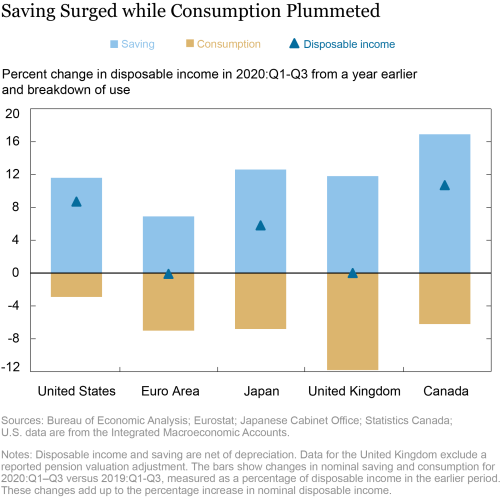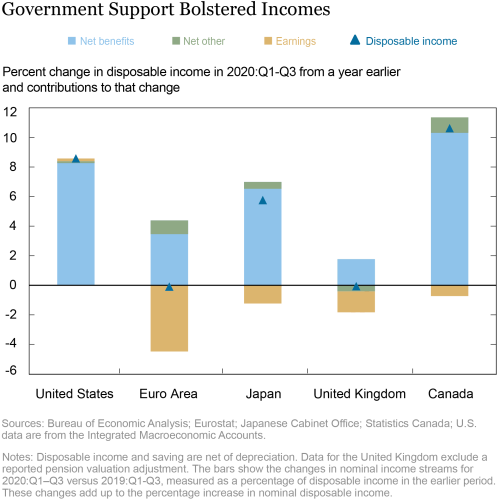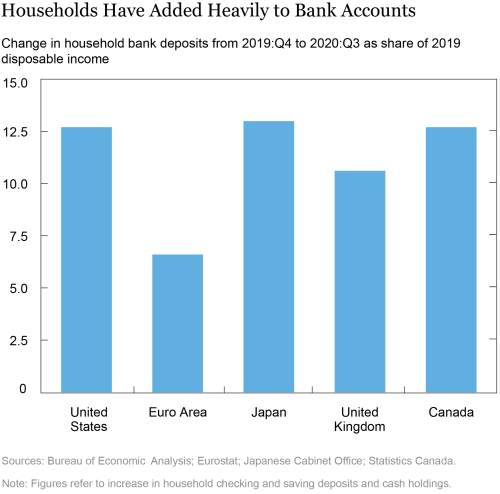Household saving has soared in the United States and other high-income countries during the COVID-19 pandemic, despite widespread declines in wages and other private income streams. This post highlights the role of fiscal policy in driving the saving boom, through stepped-up social benefits and other income support measures. Indeed, in the United States, Japan, and Canada, government assistance has pushed household income above its pre-pandemic trajectory. We argue that the larger scale of government assistance in these countries helps explain why saving in these countries has risen more strongly than in the euro area. Going forward, how freely households spend out of their newly accumulated savings will be a key factor determining the strength of economic recoveries.
The pandemic sent consumer spending into retreat, helping drive up saving
Consumer spending plummeted in the United States and other high-income economies with the arrival of the COVID-19 pandemic. The drop was sharpest in the second quarter of 2020, reflecting the strict lockdowns then in place. Spending picked up over the second half of the year, but the recovery was only partial. Consumption was still well below pre-pandemic levels at year-end.
A simple accounting identity can help clarify how changes in spending feed into saving. Since income is either spent or saved, changes in income must be matched by changes in spending and saving.
If income is stagnant, a decline in consumption will result in an equal increase in saving. If income is growing, the same decline in consumption will translate into a larger increase in saving.
The chart below shows how this relationship has played out during the pandemic for the largest high-income economies: the United States, the euro area, Japan, the United Kingdom, and Canada. The triangles represent the percent change in personal disposable income—income after taxes and net transfers—comparing the first three quarters of 2020 with the first three quarters of 2019. The bars show how these changes in disposable income map into changes in consumption and saving, consistent with the identity above.
While consumer spending weakened in all these economies, the magnitude of declines varied widely. U.S. spending held up best, dropping by the equivalent of 3 percent of pre-pandemic personal income. Spending in the United Kingdom fell the most, dropping by nearly 12 percent. Spending elsewhere was down 6 to 7 percent.
Household saving, in contrast, was up across the board, with increases ranging from 7 percent of pre-pandemic income in the euro area to 16½ percent in Canada. The counterparts to this increase varied widely. In the euro area and the United Kingdom, income stagnated, and higher saving came entirely from declines in consumption. In the United States and Canada, income grew strongly, and saving rose by more than twice the decline in consumption. In Japan, the increase in saving came about equally from lower consumption and new income.
Data through the end of 2020—available only for the United States and Canada—tell a similar story. Saving grew strongly, with the largest contribution from income, and a smaller but still sizeable contribution from lower consumption.
Notably, personal disposable income in the United States, Japan, and Canada grew by more than twice the average pace over the previous several years. The COVID-19 pandemic, of course, brought steep recessions to all high-income economies. This raises a natural question: Why did income growth hold up so well in the United States, Japan, and Canada?
Government support bolstered household incomes
Wages and other labor compensation account for the largest part of household income—more than 60 percent of income before taxes for the economies discussed here. The rest of income comes largely from private sources such as proprietors’ earnings, rents, and investment returns. (The line between labor compensation and proprietors’ income varies across countries, depending on differences in accounting practices and in how businesses are organized.) Net social benefits represent a final key category. This includes government-provided retirement benefits, unemployment insurance, income assistance, and similar programs, net of the taxes going to fund them. For some countries, net social benefits are typically a negative item for aggregate household income, with benefit-related taxes exceeding benefit payouts. What matters for our purposes, though, is how income streams changed over the course of the pandemic to yield the total change in household income.
The chart below provides a breakdown of disposable income growth, comparing the first three quarters of 2020 with the same period a year earlier. (As with our earlier chart, data through the end of 2020 are available only for the United States and Canada, and tell a similar story.) Again, the bars show contributions to this income growth. The gold bar labeled Earnings combines labor compensation, proprietors’ earnings, rents, and investment returns. The blue bar shows the net contribution from social benefits. The small green bar labeled Net other largely consists of changes in income taxes and in private transfers such as workers’ remittances.
Nominal earnings growth was negligible in the United States and negative for all other economies—hardly a surprising development given steep recessions and the resulting sharp rise in unemployment and falloff in proprietors’ income. The positive outturn in the United States seems surprising, and can be traced at least in part to a less severe downturn: Real GDP for the Q1-Q3 period was down about 4 percent in the United States, compared to a decline of more than 6 percent elsewhere.
Higher net benefits made a meaningful contribution to income growth in all economies. But the magnitude of the contribution varied widely, ranging from just under 2 percentage points in the United Kingdom to more than 8 percentage points in the United States and roughly 10 percentage points in Canada. Absent the increase in benefits, disposable income growth would have been barely positive in the United States and Canada and negative elsewhere.
What would saving have been if there had not been these higher net benefits? It is impossible to say for sure. As an accounting matter, households could have maintained the same level of saving by making even sharper cutbacks in consumption spending. But consumption declines were already large and painful. More likely, the buildups in saving would have been substantially scaled back. Moreover, an attempt to maintain saving would be at least partly self-defeating. Deeper consumption cutbacks would have translated into steeper recessions, reducing incomes across the economy—and forcing further cutbacks in consumption or saving. The perverse feedback mechanism, whereby a general increase in saving makes everyone worse off, is known as the Paradox of Thrift.
Government support went beyond social benefits
Government pandemic assistance has gone beyond higher direct transfer payments. The United Kingdom, Japan, and some euro area countries have channeled wage subsidy payments to businesses rather than workers, which means these funds show up in household incomes as wages rather than social benefits. This arrangement helps explain why earnings declines have been small given the depth of recessions. Similarly, in the United States, Paycheck Protection Program funding shows up as proprietors’ income or indirectly as wages, not as social benefits.
A look at the government accounts serves as a check on the scale of support for household incomes. Countries’ integrated macroeconomic accounts show government outlays on subsidies to the business sector. These outlays have risen substantially—by roughly half as much as the increase in social benefit payouts in the United States, the euro area, and Canada, and by four times the increase in benefit payouts in the United Kingdom. No data are yet available for Japan, but indirect evidence indicates that the bulk of pandemic assistance there is captured in the household statistics.
Unfortunately, the data do not allow us to specify what fraction of these funds were eventually paid out to households. But the upshot is clear enough. Government support for household incomes and saving was larger than suggested by the increase in social benefits—dramatically so in the United Kingdom. The euro area continues to stand out for support that is large relative to history, but small relative to what has been enacted elsewhere.
Will households spend down “excess” saving?
How freely households spend out of their newly accumulated savings will be a key factor determining the strength of economic recoveries. Consumer spending would soar if households run down these funds aggressively when economies reopen. The potential upside is underscored by the fact that much of the buildup in savings is being held in easily spendable form. As the chart below shows, household deposit holdings for the five economies discussed here have risen by an amount equivalent to between 6.5 and 13.0 percent of annual disposable income.
A recent Liberty Street Economics post, however, provides reasons for thinking that spending out of recent savings will be relatively modest based on how spending typically responds to an increase in the nation’s wealth. As noted in that post, goods consumption in the United States is already above its pre-pandemic trend. The same is true in other advanced economies. In addition, most consumer spending on services goes to essentials such as housing, utilities, education, and healthcare. There is only so much pop that pent-up demand for services such as travel, restaurant meals, and entertainment can deliver.
This isn’t to discount the upside potential for growth this year and next, particularly for the United States. Data in 2020 already place the scale of U.S. government support for households toward the upper end of the advanced economy range. The additional U.S. fiscal package passed in December boosted household incomes and savings starting in January, and the much larger package passed in March will add even more.
 Matthew Higgins is a vice president in the Federal Reserve Bank of New York’s Research and Statistics Group.
Matthew Higgins is a vice president in the Federal Reserve Bank of New York’s Research and Statistics Group.
 Thomas Klitgaard is a vice president in the Bank’s Research and Statistics Group.
Thomas Klitgaard is a vice president in the Bank’s Research and Statistics Group.
How to cite this post:
Matthew Higgins and Thomas Klitgaard, “What Is behind the Global Jump in Personal Saving during the Pandemic?,” Federal Reserve Bank of New York Liberty Street Economics, April 14, 2021, https://libertystreeteconomics.newyorkfed.org/2021/04/what-is-behind-the-global-jump-in-personal-saving-during-the-pandemic.html
Disclaimer
The views expressed in this post are those of the authors and do not necessarily reflect the position of the Federal Reserve Bank of New York or the Federal Reserve System. Any errors or omissions are the responsibility of the authors.














 RSS Feed
RSS Feed Follow Liberty Street Economics
Follow Liberty Street Economics